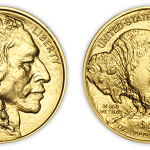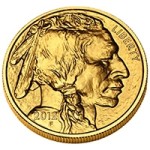The American Buffalo Gold Coin
Disclosure: We are reader-supported. If you purchase from a link on our site, we may earn a commission. Learn more
The American Buffalo coin, often called the “Gold Buffalo”, is the first pure, 24-karat gold bullion minted by the United States government. American Buffalo coins meet the purity requirements for bullion investing in an IRA, as set forth by the IRS. Since its introduction, this coin has rapidly increased in value and popularity among investors and collectors. On this page, you'll learn everything you need to know about the “Gold Buffalo.” https://www.youtube.com/watch?v=5faZA-rHjaQ
Development, Introduction and History
The US Congress authorized the production and sale of American Buffalo bullion coins through the Presidential $1 Coin Act of 2005 (Public Law 109-145). Per the Act, all gold used in the production of American Buffalos must be from newly-mined sources in the United States. All US Bullion coins are struck at the West Point Mint in New York. The development and release of American Buffalos was partially driven in response to some investors opting to purchase foreign pure-gold bullion, rather than the American Gold Eagle coins (91.6% gold alloy). Shipment for the American Buffalo began on July 13, 2006. The coin also comes in a ‘proof‘ variation. ‘Proof' American Buffalo coins undergo a modified minting process, whereby special dyes are used when the metal is pressed. The ‘proof' coins are then struck multiple times, generating a mirror-like polish on both sides. The Presidential $1 Coin Act placed a strict 300,000 coin limit on ‘proof coins', helping establish their rarity. The Act also imposes a limit of ten American Buffalo ‘proof' coins per household.

Later, an uncirculated version of American Buffalo coins was made available for purchase. American Buffalo Uncirculated coins undergo a different minting process than other American Buffalo coins, but are very similar in appearance. The term “uncirculated” refers to the fact that these coins are not legal tender, and carry no transactional value. Uncirculated coins tend to sell at a lower cost than bullion or ‘proof' coins. On September 26, 2008 the US Mint halted the sale of American Buffalo coins. In a statement explaining the decision, the Mint stated “Demand has exceeded supply for American Buffalo 24-karat gold one-ounce bullion coins, and our inventories have been depleted. We are, therefore, temporarily suspending sales of these coins.” Production and sale has since resumed.
American Buffalo Physical Characteristics
Coin Design

For the American Buffalo design, the US Mint selected images from the “Indian Head Nickel” (“Buffalo Nickel”) coin, which it produced from 1913 to 1938. The American Buffalo images are a slightly modified version of James Earl Fraser's depictions of a Native American Indian head on the front (obverse) side, and an American Buffalo standing on a mound on the rear (reverse) side. This design was also featured on the 2001 Smithsonian commemorative coin. The word “LIBERTY” appears on the obverse side of American Buffalo coins. The reverse side includes the phrases “IN GOD WE TRUST“, “E PLURIBUS UNUM” along with “UNITED-STATES-OF-AMERICA.” Located inside the mount on which the buffalo stands, it reads “$50 1 OZ. .9999 FINE GOLD.” Fraser stated that the face of the Native American Indian was the blend of three separate tribes – Big Tree, Iron Tail and Two Moons. There is one visible braid and two eagle feathers in the hair of the Native American Indian. The beast on the reverse side is widely believed to be a famous bison named Black Diamond, an inhabitant of New York's Central Park Zoo during the early 1900s.

Specifications
American Buffalo coins have been offered in four different weight denominations, though 1/2 oz, 1/4 oz and 1/10 oz American Buffalo were only available in 2008. Currently, only the 1 oz coin is available for production and sale. The specification set by the US Mint for the 1 oz coin are as follows:
| Composition | 99.99% Gold (24K) |
| Mass | 1.0001 troy ounces |
| Diameter | 32.70 mm. |
| Thickness | 2.95 mm |
American Buffalo Pricing
American Buffalo bullion is considered legal tender in the United States and each weight denomination carries a face value, or transactional worth as dictated by law. The face value, however, is largely symbolic. An American Gold Buffalo coin is almost always priced and sold according to its intrinsic value, or value determined (largely) by the price of gold in the market. The market price is the value used for American Buffalo coins which are used in an investment portfolio. When sold, typically, a premium is added to the market value to account for coinage and distribution costs. Since the market price of gold fluctuates daily, so too does the market value of American Buffalo coins. Most major newspapers will list a daily price of gold, making it simple to track an investment in the coin.
Investing in American Buffalo Coins Through an IRA
The “Gold Buffalo” coins are a great option for investors looking to add high-purity bullion to their IRA. The purity of these coins are guaranteed by the United States government.

The Internal Revenue Service allows specific types of IRAs to carry gold, silver, platinum and palladium bullion in a portfolio. Sometimes referred to as a “precious metals IRA“, these IRAs are self-directed and may only contain IRS-approved bullion – such as American Buffalo gold coins. Any IRS-approved bullion must meet minimum purity requirements. In addition, the required minimum purchase amount of bullion to establish a precious metals IRA is $5,000. All subsequent purchases must be at least $1,000. Those with existing IRAs have the option of transferring or rolling over funds from another qualified retirement account into a precious metals IRA. In addition, the IRS requires that all investment bullion be held in a ‘depository' responsible for the security and maintenance of precious metals. American Buffalo Gold bullion coins are not available for purchase directly from the US Mint. Instead, bullion coins are distributed to qualifying brokerage houses and banks. These institutions purchase the coins, in bulk, at a slight premium above market value. The US Mint does allow direct purchase of American Buffalo ‘proof' coins and American Buffalo Uncirculated coins at a fixed price.
Sign up to learn more. It's free!
If you're worried about the economy and want to learn tips on how to protect your retirement savings in case of another systemic collapse, sign up to our monthly newsletter now for free! We cover topics such as: precious metals investing, inflation, currency devaluation, national debt, the Fed's financial policies, world politics, and much more. Join now and we'll send you a free PDF report entitled “5 scams to avoid when investing in bullion gold & silver”



 Silver
Silver Gold
Gold Platinum
Platinum Palladium
Palladium Bitcoin
Bitcoin Ethereum
Ethereum
 Gold: $3,330.67
Gold: $3,330.67
 Silver: $36.82
Silver: $36.82
 Platinum: $1,384.05
Platinum: $1,384.05
 Palladium: $1,126.20
Palladium: $1,126.20
 Bitcoin: $108,174.39
Bitcoin: $108,174.39
 Ethereum: $2,550.40
Ethereum: $2,550.40